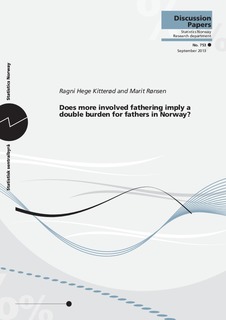Does more involved fathering imply a double burden for fathers in Norway?
| dc.contributor.author | Kitterød, Ragni Hege | |
| dc.contributor.author | Rønsen, Marit | |
| dc.coverage.spatial | Norway | nb_NO |
| dc.date.accessioned | 2019-11-12T12:04:06Z | |
| dc.date.available | 2019-11-12T12:04:06Z | |
| dc.date.issued | 2013-09 | |
| dc.identifier.issn | 0809-733X | |
| dc.identifier.uri | http://hdl.handle.net/11250/2627922 | |
| dc.description.abstract | While long total work hours (paid plus unpaid work) have usually been framed as a problem for employed women, researchers now ask whether more involved fathering practices imply a double burden for men, too. Based on the Norwegian Time Use Survey 2010, and using three different measures of total workload, our analyses suggest that the father’s total workload exceeds the mother’s when he works full time and she part time and there are school-aged children in the household. Fathers also perceive more time pressure than mothers in these couples. Full-time work for both partners may give a longer total workload for mothers, but the difference is more modest than in full-time / part-time couples and is not statistically significant in our sample. Gender differences in total workload vary during the week, with longest hours for fathers on weekdays, and longest hours for mothers on weekends. | nb_NO |
| dc.language.iso | eng | nb_NO |
| dc.publisher | Statistisk sentralbyrå | nb_NO |
| dc.relation.ispartofseries | Discussion papers;753 | |
| dc.subject | JEL classification: D13 | nb_NO |
| dc.subject | JEL classification: J18 | nb_NO |
| dc.subject | JEL classification: J21 | nb_NO |
| dc.subject | JEL classification: J22 | nb_NO |
| dc.title | Does more involved fathering imply a double burden for fathers in Norway? | nb_NO |
| dc.type | Working paper | nb_NO |
| dc.description.version | publishedVersion | nb_NO |
| dc.subject.nsi | VDP::Matematikk og Naturvitenskap: 400::Matematikk: 410::Statistikk: 412 | nb_NO |
| dc.source.pagenumber | 36 | nb_NO |
Files in this item
This item appears in the following Collection(s)
-
Discussion Papers [1002]
